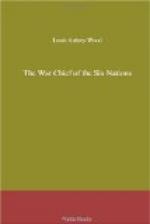CHAPTER XV
THE PINE-TREE TOTTERS
It came to pass before long that the Indians wished to dispose of some of the land granted to them on Grand River. The United Empire Loyalists and others, lured by the prospect of cheap land, kept crossing into Canada from the United States; accessions to the population of the Great Lakes region had come by immigration from the British Isles, and the country was making forward strides. Straggling settlers and speculators were often anxious to purchase land in the richer districts when they could get it at a low price. It happened, however, that after the redskins had sold and leased bits of their territory to such persons, the provincial government began to interfere. The land, it said, belonged to the Indians only so long as they remained upon it. They could not, therefore, sell any of it, as they had no direct ownership of the soil.
This decision shed a new light upon the proprietary rights of the Six Nations in Canada and the Indians were sorely perplexed. All along they thought that they held their lands like other settlers who had proved their loyalty. Brant vigorously took up their case, made several able speeches on their behalf, and freely corresponded with the authorities of the province regarding the matter. In 1793 Governor Simcoe issued a new proclamation respecting the grant, but this did not end the dispute. The province still claimed the right of pre-emption with respect to the whole of their reserve. Later on the matter was carried to England, and the British government tended to favour the Indians’ claims. But nothing was done, owing to contentions among the redskins themselves. It was only, indeed, after Brant’s death that the affair was finally settled. The sale of large tracts of Indian land was then authorized, and the money received was safely invested for the benefit of the Mohawks and others of the Six Nations in Canada. In connection with this difficult question Brant had intended making a trip to England, but was forced to abandon the idea.




